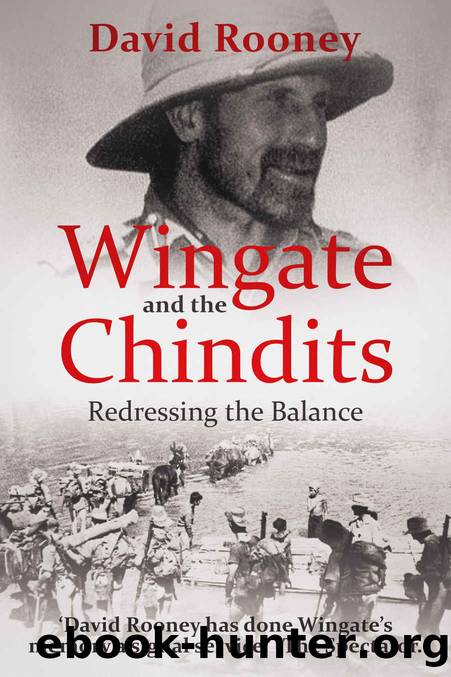Wingate and the Chindits: Redressing the Balance by Rooney David

Author:Rooney, David
Language: eng
Format: epub
Publisher: Sharpe Books
Published: 2019-06-09T16:00:00+00:00
8
The Final Chindit Campaigns
Morris Force and Dah Force, which had flown into âChowringheeâ with 111 Brigade starting on 6 March, operated along the Bhamo-Myitkyina road which, after the successful blocking of the Indaw-Myitkyina road and rail route by 77 Brigade, became the most crucial supply route for the Japanese divisions fighting Stilwell in the north. The members of Morris Force and Dah Force to some extent felt that the great battles of 77 Brigade under Mike Calvert at âBroadwayâ and âWhite Cityâ had relegated them to the sidelines, but the operations they conducted against the Japanese on the Bhamo-Myitkyina road were extremely important both in themselves and because they illustrated Wingateâs remarkable strategic grasp of the whole Burma theatre. The basic concept of LRP was to destroy the enemy lines of communication, and this coloured all Wingateâs plans.
The successful actions at âBroadwayâ and âWhite Cityâ affected particularly the Japanese 18 Division fighting Stilwell, and their 31 Division making for Kohima. But it also highlighted the importance of the Bhamo road as the supply route for 18 Division, as well as 36 Division fighting against Chiang Kai Shekâs forces along the Salween river.
Wingate realised in advance how significant the Bhamo-Myitkyina road would become, and he therefore detached from 111 Brigade one whole battalion â 4/9 Gurkha Rifles â under Lieutenant-Colonel Morris, and ordered it to operate against the road with two Columns, 94 and 49. In addition, a small force under Lieutenant-Colonel Herring and known as Dah Force, was sent in to encourage the loyal Kachin people to rise in rebellion against the Japanese, and to help Morris Force to block the road up to Myitkyina permanently. For long stretches through Kachin country, the road passed below hillsides which were ideal for a guerrilla force intent on ambush and on the destruction of the road. Peter Cane, the leader of 94 Column said, âIt was truly a guerrillaâs dreamâ.
Unfortunately, two factors militated against the success of Morris Force. Because of the urgent priority given to supplies to 77 Brigade, and the very substantial distances from Morris Force back to base, their demands for supplies, for explosives and for air-strikes were time and again left unanswered. A second adverse factor in the operations of Morris Force lay in the poor quality of leadership, which became apparent very soon after the operation started. Lentaigne and Morris â old pre-war pals â had never fully accepted Wingateâs philosophy, or his example of leading from the front. The training of 111 Brigade was inadequate and, significantly, when 77 Brigade flew in to âBroadwayâ, the Brigadier and the CO (Calvert and Scott) were in the leading gliders, while in contrast, when Morris Force flew in to âChowringheeâ, Morris arrived later by Dakota when all was captured and a landing strip prepared, and Lentaigne came in even later than that.
Morris Force and Dah Force illustrate both the possibilities and the problems of Chindit-style operations. They had their successes and their failures and then, like most of the
Download
This site does not store any files on its server. We only index and link to content provided by other sites. Please contact the content providers to delete copyright contents if any and email us, we'll remove relevant links or contents immediately.
| Africa | Americas |
| Arctic & Antarctica | Asia |
| Australia & Oceania | Europe |
| Middle East | Russia |
| United States | World |
| Ancient Civilizations | Military |
| Historical Study & Educational Resources |
Magic and Divination in Early Islam by Emilie Savage-Smith;(1498)
Ambition and Desire: The Dangerous Life of Josephine Bonaparte by Kate Williams(1342)
Bohemians, Bootleggers, Flappers, and Swells: The Best of Early Vanity Fair by Bohemians Bootleggers Flappers & Swells- The Best of Early Vanity Fair (epub)(1341)
Papillon by Henry Charrière(1305)
Twelve Caesars by Mary Beard(1253)
Operation Vengeance: The Astonishing Aerial Ambush That Changed World War II by Dan Hampton(1134)
What Really Happened: The Death of Hitler by Robert J. Hutchinson(1126)
London in the Twentieth Century by Jerry White(1110)
Time of the Magicians by Wolfram Eilenberger(1084)
Twilight of the Gods by Ian W. Toll(1083)
The Japanese by Christopher Harding(1081)
Lenin: A Biography by Robert Service(1041)
The Devil You Know by Charles M. Blow(983)
A Social History of the Media by Peter Burke & Peter Burke(936)
Freemasons for Dummies by Hodapp Christopher;(921)
Napolean Hill Collection by Napoleon Hill(900)
Henry III by David Carpenter;(890)
The Churchill Complex by Ian Buruma(879)
The Rise and Triumph of the Modern Self by Unknown(877)
